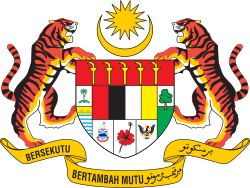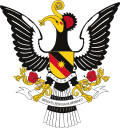National
| Arms | Date of adoption | Use | Description/Blazon |
|---|---|---|---|
 | 1988 | Coat of arms of Malaysia (Jata Negara) | Crest: A crescent and a fourteen-pointed federal star Or. Shield: Tierced per pale, the second three-and-a-half times as wide as the other two: The first (at dexter) per fess of three: Argent, on a wreath of the colours upon a mount an areca nut-palm leaved and fructed Proper, Or a representation of the Penang Bridge proper and barry wavy of ten Azure and Argent; the second per fess, in chief paly of four Gules, Sable, Argent and Or, in base paly of three all Argent, the Coat of Arms of Sabah, a Bunga Raya (hibiscus flower), and the Coat of Arms of Sarawak all proper; the third (at sinister) Argent, a Malacca tree standing on a base proper; and a chief Gules, five krisses in their sheaths, per pale Or. Supporters: Two tigers rampant proper. Motto: Bersekutu Bertambah Mutu (Unity is Strength) in Rumi (Latin) and Jawi scripts. |
 | 1952–1963 | Coat of arms of the Federation of Malaya from 1952 to 1963 | Crest: A crescent and an eleven-pointed federal star Or. Shield: Tierced per pale, The first (at dexter) per fess embattled Or and barry wavy of eight Azure and Argent in chief a plume of three ostrich feathers surmounted by a riband of the Second on the riband the words Ich Dien in letters of the First; the second (at fess point) quarterly Argent, Gules, Sable and Or; the third (at sinister) Azure, a representation of the gate of A Famosa Proper; and a chief Gules, five krisses in their sheaths, per pale Or. Supporters: Two tigers rampant proper. Motto: Unity is Strength in English and Bersekutu Bertambah Mutu in Jawi Malay scripts. |
 | 1963–1965 | Coat of arms of Malaysia from 1963 to 1965 | The Federation of Malaysia arms in use between 1963 and 1965, with three new member states added to the bottom: Sabah (Argent, Crest of the Coat of Arms of Sabah Proper), Singapore (Gules, a crescent facing a pentagon of five mullets Argent) and Sarawak (Or, on a cross parted per pale Sable and Gules, an Eastern Crown of the field). Additionally, the A Famosa Gate of the Malacca section was replaced by the Malacca tree ( phyllanthus emblica ). |
 | 1965–1973 | Coat of arms of Malaysia from 1965 to 1973 | Following the separation of Singapore from the Federation, its section was replaced with that of a Bunga Raya ( hibiscus × rosa-sinensis ). |
 | 1973–1982 | Coat of arms of Malaysia from 1973 to 1982 | Sarawak had changed its coat of arms to a Rhinoceros hornbill. |
 | 1982–1988 | Coat of arms of Malaysia from 1982 to 1988 | Sabah changed its coat of arms to a kingfisher albeit short-lived, while Penang Bridge replaced the Prince of Wales's feathers and the battlement. Additionally, the areca nut palm ( areca catechu ) from the Coat of arms of Penang was placed on top of the Bridge, and the number of the sea waves under the bridge was increased from eight to ten. |





























